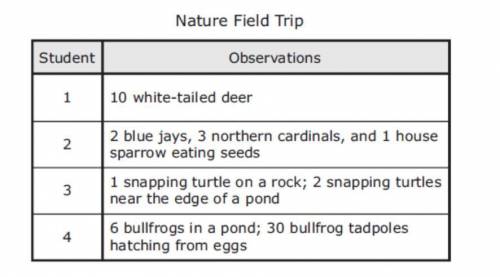
Biology, 20.09.2020 18:01, brooke2337
The following table shows the observations made by some students in a science class. Determine the levels of biological organization described by each student, 1-4.


Answers: 1
Other questions on the subject: Biology

Biology, 21.06.2019 20:30, alevans7144
For your initial isolation of the bacterium, you simply needed to grow enough of it that you could identify some of its more general features. thus, you used a complex nutrient agar that would allow for the growth of almost any bacterial species. different bacterial species often have very specific requirements for life. this is a fact that you can utilize when you are trying to identify the bacterium to the species level. growth conditions that will permit the growth of one species but not another may allow you to select which one you would like to culture. you can utilize different selective/differential media that allow for the growth of only one type of bacteria (e. g., either gram positive or gram negative). culturing media such as phenylethyl alcohol or sodium chloride agar will be selective/differential for gram-positive bacteria. you may also want to show that it is different from other bacteria that may be present, so you could use a selective/differential agar. selective/differential media such as blood agar or phenol red sugar broths allow for the determination of whether a bacterial cell can grow and utilize specific ingredients included in the medium and turn the agar a distinct color. sheep's blood agar utilizes red blood cells to differentiate which bacterial species may have hemolytic properties. selective or differential? 1. an agar that uses a high salt concentration to limit the growth of one type of bacteria over another would be considered selective/differential. 2. if an agar contains a dye or ph indicator in the presence of a sugar, it is generally considered selective/differential for those bacteria that may ferment the sugar over those that cannot. 3. an agar that uses the dye in crystal violet agar suppresses the growth of gram-positive bacteria. this agar would be considered selective/differential. 4. the selective/differential aspect of macconkey agar allows for the determination of which bacteria are lactose fermenters and which are not. 5. a blood agar plate contains sheep red blood cells and allows for the determination of hemolytic capabilities for all bacteria that grow on the agar. this would make this type of agar selective/differential. 6. emb agar uses lactose and two dyes that allow it to be selective/differential between the blue-black colonies of e. coli and the pinkish colonies of all other enteric bacteria. 7. bile salts in macconkey agar allow for the agar to be selective/differential for the growth of enteric gram-negative bacteria over gram-positive bacteria. 8. an agar that allows for the distinction of bacteria based on metabolism would be considered selective/differential.
Answers: 1

Biology, 21.06.2019 22:00, bighomie28
Does mitochondria still meet the definition of a eukaryote why or why not?
Answers: 3

Biology, 22.06.2019 02:30, brenyasanders5345
Many plants can reproduce asexually. which of these is an example of asexual reproduction in a plant? a. pine cones forming on a tree b. cross-pollination in a tomato c. roots sprouting from a potato d. night-blooming jasmine flowers
Answers: 3

Biology, 22.06.2019 05:00, topangabraith
Patient has just received an organ transplant which treatment would be most effective in preventing the patient’s body from
Answers: 2
Do you know the correct answer?
The following table shows the observations made by some students in a science class. Determine the l...
Questions in other subjects:


Mathematics, 13.01.2021 22:40




History, 13.01.2021 22:40


Health, 13.01.2021 22:40

French, 13.01.2021 22:40







